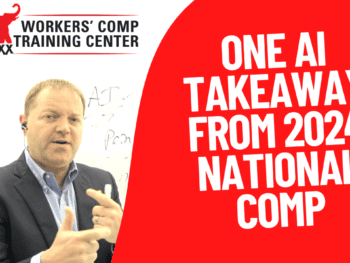This is a 16 Minute preview of the complete course “How to Create and Implement a Workers’ Comp Cost Allocation System” Register for the complete on-demand course here: https://workerscomptraining.com/registration-cost-allocation/
Yeah. Hello everyone and welcome to workers’ comp mastery training. My name is Michael stack and I really couldn’t be happier than for you to be joining us for this training session today. What I think you’re going to find is you’re going to find some information and some contacts on a very important topic, which is how to motivate behavior, how to motivate behavior, which is the essence of what is the title of our training, which is how to create and implement a worker’s comp cost allocation system. Because if you think about it, it’s not a mystery of how to do it. It’s not a mystery of how to reduce workers’ compensation costs. We know what those fundamentals are. We know return to work. We know Andrew response, we know how to work with your adjusters. You can go to a bunch of our trainings to learn all those fundamentals in detail.
It’s Not A Question of HOW…It’s a Question of MOTIVATION
So it is not a question of how to do it. It’s been done successfully for years and decades by hundreds and thousands of companies. So then the question becomes if it’s not a question of how, how to add two plus two it’s a question of how to motivate engagement, how to get buy in from your senior managers, from your supervisors, from your employees and from your upper management at the organization. Because if you have that, if you have that vine, if you have that engagement then you will be successful period. If you have that buy in, if you have that engagement you will be successful period because we know how to do what the prep, the tactics are so well proven and documented for what [00:02:00] works. So we’re going to be talking about today is have you not get sort of caught up in sort of this minutia of the actual elements of cost allocation, which we will be talking about going over and examples we’re looking at numbers but going through all that in detail, what we’re gonna be talking about is the greater picture then of motivation.
Click Link to Access Free PDF Download
So here’s what that looks like. Then as far as the three major points of how we’re going to kind of flow through today’s session. So the first major point is we’re going to be talking about these drivers of behavior. What are those drivers of behavior in sort of getting into that greater context as I was referencing of what actually motivates us to engage. Second piece then is these actual cost allocation systems. We’re going to go through the examples. We’re go through different methods. We’re going to be looking at numbers, what have you sort of going through how companies do this, how they set it up, actually, what does it look like from a setup and numbers standpoint and like I said, we were going through some examples of that and then the third piece then is then those steps to actually implement this cost allocation. What are those steps?
The Greater Picture of Motivation
Then once you know kind of these nuts and bolts, once you know the greater picture of motivation, how do you then implement this into your organization? A couple of quick administrative points before we get going. The outline for today’s session is in the GoTo webinar interface, so it’s a word document. You can download that, take some notes right along there. There’s also a lot of good examples in there, so if you’re not able to kind of follow along. If I write something on the board and I erase it and you meant to see it, that’s a great place to reference it. That’s the outline for this today’s session. That’s what I follow when we’re going through the session. It’s a great thing to reference. You can get it there. I know sometimes some people with firewalls and things have trouble downloading that. Another place to look at that is in the final email that I just sent you that said we are starting now.
There’s a link in there where you can download that as well. And then the other piece that I want to encourage you to do too is this is a live session. The greatest thing and one of the greatest things about this style is that we can work together. So I encourage your comments. I encourage your questions. I do have my big screen right behind the camera here, so when you type something in, I’ll be able to address that as best we can through the out today’s so get, let’s get right down then into this first major point, which I think is really the most interesting. You know it’s the most sort of theoretical, but it’s also the most interesting and also as we’re getting into this topic, the most important because if we look at it as I referenced earlier, we’re going to be talking about this in several different instances.
If You Are Only Looking At Numbers, You are Missing the Point
If you’re looking only at the numbers, then you’re missing the point of this entire training and you’re missing the effectiveness of what a cost allocation system can actually do. Okay, so I want to lay out the context of this sort of idea of motivating behavior. And I want to start with this research study that was done by MIT and what it was called. It was called large stakes and big mistakes. So large stakes and big mistakes was the name of the research study. And here’s what they did is they took a group of students and this study has been replicated many different times. They did in India, they did it at MIT, they did it out in California. They’ve done it many different times. So here’s what they did is they said, okay, we want you to do this set of tasks of what they were looking at and studying was this reward system.
So we always think, and sort of the typical thing that we always think because we think that results and rewards are perfectly correlated. So we always think if you give a bigger reward, then you can expect that to drive behavior. That should be a one to one symbiotic relationship. If we give you a bigger reward that’s going to drive your behavior, that should drive greater results. So that’s what they were testing. So they split the kids up into different groups and they asked them to do these tasks. So memorize digits, do word puzzles, shooting a ball through a hoop, very sort of rudimentary tasks, pounding in a nail, things like that. Things that don’t really require a huge amount of thought. It’s just kind of go, go, go, go, go, go, go, go, go, go, go, pound as many nails in as you possibly can.
The Bigger the Reward, The Greater the Result?
And the more nails you pound it in, the bigger the results, the bigger the rewards. Fantastic. And as they look at those results that held true. So that was that sort of one-to-one relationship that we kind of expect and that sort of made sense, make bigger reward, bigger results, fantastic. Then they asked them to do a little bit more difficult, a little more tasks that required a little bit more cognitive skill. So a little bit more thinking involved in regards to these tasks. And here’s what they found is they found actually the exact opposite of what we would expect. So what they found was the bigger the reward, I’ll, maybe I’ll do this in blue so we can differentiate. What they found is the bigger the reward. Then I just grabbed my black, all right, here we go. Bigger. The reward actually the worse the results.
So the bigger the reward, the worse the results. And that finding was, as I already mentioned, anytime the skill that they were testing required even a little bit, even just a little bit of cognitive skill, more than just palmed in the hammer and pounding the nail pounded them in as many as you can. Anytime they required a little bit more thinking involved. The reward system that we expect was the exact opposite of what actually happened. So I want you to kind of think on that sort of conclusion for a second because if you can grasp that conclusion of why that’s the case, you can grasp this entire essence of what I talked about in that opening statement there of cost allocation and how to do it most effectively. I’m going to say that again, think about this result, this sort of opposite result of what we would expect.
The Goal is to Motivate Behavior
If you can grasp that concept of why that’s true, which we’re gonna talk about here in a second, you can grasp the entire effectiveness of everything involved in success in setting up a successful cost allocation system. Cause remember as we said, all we’re trying to do here is motivate behavior. We’re trying to have those results be better. And we’re looking at this reward system. This is all we’re doing in a cost allocation system really at its core. So if you have that in your mind, I want to talk about this sort of next sort of description of it or why that’s the case and the little bit more data [00:08:30] that was gathered and studies that I’ve done research that I’ve done that has been done to prove why that’s the case and that a study and that sort of context comes from the book called drive.
So it’s a book called drive written by the author Daniel pink. So if you’re interested in sort of this motivation and motivating behavior concept, great book, I highly recommend checking out a lot of really interesting information that he talks about in the, in that drive. Okay, next piece here, and I want to talk about sort of the, the why that’s the case. So why was that opposite results and rewards came out when it causes a little bit of cognitive skill. And if you think about worker’s compensation and work comp management, it requires a little bit of cognitive skill. There’s some complexity, certainly involved. There’s some human emotion involved, there’s a lot of stakeholders involved. So we’re definitely falling into that requires cognitive skill category. So want to bring your attention now here and what this is is this is something that we all probably learned.
Hierarchy of Motivation at Work
I don’t know if you’d go over this in grade school or high school, but this is Maslow’s hierarchy of needs. And so on the bottom you have the physiological needs and then as you move up the pyramid here you’ve got security, you’ve got a belonging, love and belonging, you’ve got the next, you have self esteem, and then you have self actualization. And we’ve probably seen all this before. And then we can kind of understand this general concept of this is your, your basic needs, you need to get those squared away, food, water, shelter, et cetera. That’s at the bottom of that period pyramid. And as you move up this of what actually drives our motivation, what drives our behavior, what drives us as individuals to want to be better and want to do better and wants to pursue more. That’s as you move up this chain, there’s a great article written by Roosevelt moth Moss Kanter in the Harvard business review and here’s what Rosa Beth has to say about motivation and that reward results, rewards dichotomy that we were kind of just talking about.
Roosevelt says the key to motivation doesn’t depend on elaborate incentive schemes. What makes a good work environment is getting better at stuff or mastering a task. So the key to motivation doesn’t depend on elaborate incentive schemes. What makes a good work environment is getting better at stuff or mastering a task. As we now start to kind of internalize what that might mean in regards to this rewards and incentive schemes. I want to add one more layer to this to have you start to think about, so Roosevelt came up with what she calls the four M’s, so the four M’s and those four M’s are money. Next up then is membership. So money, membership mastering. And at the top there is meaning.
So her four M’s are money, membership, mastery and meaning. And if you lay these over Maslow’s hierarchy of needs, you can see quite a connection in what’s actually driving our behavior. And what I want you to pull out of this is what I talked about in my opening statement, because if you’re missing this point, you’re missing the real value of what a cost allocation system can do for an organization. The point of what she’s talking about and, and, and that sort of root rewards results scheme is they use something very basic such as money. And if you see here, when we, what we all sort of think about when we think about a rewards or a bonus system is we think we always go here. We always go to money and we stop there. We always go to money. And that’s where we stopped. And so if you look at this, as far as we all need money, everyone needs money.
FREE DOWNLOAD: “Step-By-Step Process To Master Workers’ Comp In 90 Days”
Money Is Not the Best Motivator
Of course you got to pay the bills, you got to pay your mortgage, you gotta pay every whatever you gotta pay. You gotta pay for school, you got to do this and that. Everybody needs money. That’s at the bottom of this pyramid and everybody has food, shelter, clothing, all that stuff costs money. So you need money in order to do all that. But if you look at actually what is really driving our behaviors, what is really motivating us to pursue more, what it’s really mourning of us to be fully, fully engaged, which is what we’re trying to do here with this cost allocation system, is get people engaged in what the heck it is that we’re doing here and work on management. You got to think further up this chain and as Roosevelt said, it’s not about incentive schemes. What’s comes down here. It’s not about coming up with these elaborate schemes that people can make more money as long as they have enough to buy the stuff that they need.
They’re in pretty good shape and that’s only gonna get them so far. As you move up here, particularly as we’re talking about division leaders and we’re talking about these operations managers, you’re talking about a store, a location owner, or you’re talking about someone that’s in a bit of a higher position within an organization. When you’re talking about these cost allocation systems, that’s the level that we’re really talking about here. You’ve got our supervisor training when you’re talking about the supervisors and really getting them involved, and that’s a little bit of a different conversation when you’re talking about our metrics and you’re trying to get the senior managers involved, the upper management at the organization. That’s a little bit of a different conversation to get them fully engaged. When you’re talking about these division leaders, these operational leaders, as you’re thinking about this cost allocation system specifically, you need to start thinking about these higher levels of engagement.
These individuals are have some responsibility at the organization and they’re going to be more engaged. The more they can want to get better at it, the more meaning that they can put within the work that they’re doing. Then they’re going to be fully engaged. If you just talk about them, about money that might move the needle just a little bit. But if you want it to go off the charts, you need to start thinking about some of these other items as far as what actually drives behavior. So [00:15:00] if you think about that, results in rewards study from MIT of the large mistakes and big stakes and large mistakes. The reason that that was different is because the rewards and results was different because they were strictly focusing down here. And oftentimes those people that are fully engaged in what they are doing, and you would do it anyway.
You’re Doing It Because You Want to Get Better
You know, think about if you’ve ever picked up a guitar and you’re like, Hey, I just love playing guitar. And every night you’re practicing the songs and you’re singing, you’re having a great time, you’re never going to be on the stage with the rolling stones, but you just really enjoy it. You’re doing it because you want to get better at something or you’re doing it because you’re doing it with your kids and you find a great amount of meaning in that. That’s how you get fully engaged. And so when you think about sort of those levels of engagement, that’s when you can really start to cook with gas in regards to bringing in that element or bringing in some of that element to this cost allocation system that we’re going to be talking about. Getting into kind of some of the nuts and bolts of it.

Contact: mstack@reduceyourworkerscomp.com.
Workers’ Comp Roundup Blog: https://blog.reduceyourworkerscomp.com/
©2019 Amaxx LLC. All rights reserved under International Copyright Law.
Do not use this information without independent verification. All state laws vary. You should consult with your insurance broker, attorney, or qualified professional.
FREE DOWNLOAD: “Step-By-Step Process To Master Workers’ Comp In 90 Days”














